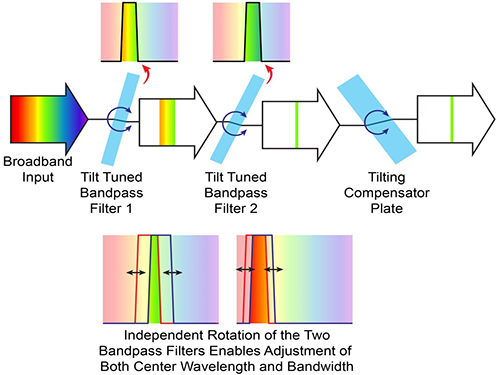TwinFilm™ technology was developed by Spectrolight to provide a simple and cost-effective means to filter light according to wavelength. This patented, next-generation technology provides a superior alternative to monochromators and AOTFs in fluorescence microscopy, hyperspectral imaging, machine vision and other applications. TwinFilm technology is also used in Spectrolight’s off-the-shelf, Custom Select Bandpass Filters – fixed bandpass filters with user-specified bandwidth and center wavelength, featuring 48 hour shipping.

TwinFilm™ technology combines two broadband bandpass filters in a compact, light-tight housing in an arrangement that enables independent rotation of the angle of incidence of each filter. As shown in the figure, this means that both center wavelength and bandwidth of the transmitted light from any collimated source are fully adjustable. Just as important, a third glass plate is simultaneously rotated to offset any slight walk-off in the beam path as the angles of incidence are set or swept. In this way, the bandwidth of TwinFilm™ products can be user or factory adjusted anywhere between 1.5 nm and 20 nm. And, the center wavelength can be chosen to be at virtually any visible wavelength (350 nm – 900 nm).
TwinFilm™ delivers several key advantages. Like a grating-based device, the out of band extinction is very high (10-6). But, unlike a grating monochromator with a narrow slit geometry, the spectral performance of a TwinFilm™ device is uniform across 95% of the large (up to 10 mm diameter) clear aperture, which is ideal for spectral filtering in imaging applications, such as microscopes and machine vision systems. Plus, at 75% transmission, TwinFilm™ is much more efficient than diffraction based devices like gratings and AOTFs. And unlike an AOTF, there is no walk-off as wavelength is changed because of the offset correction optic. Economical, factory-set TwinFilm™ devices (Custom Wavelength Selectors) also make superior bandpass filters – they can be completely custom user specified, unlike the case of single bandpass filters, which often require expensive custom thin film design and volume fabrication to achieve this same level of performance.




